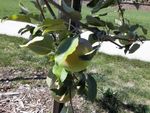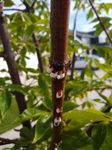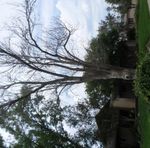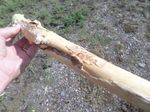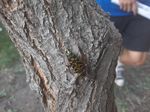Tree Pest Alert - SDSU Extension
←
→
Page content transcription
If your browser does not render page correctly, please read the page content below
Tree Pest Alert
August 25, 2021 Volume 19, Number 28
In This Issue Plant development for the growing
Plant Development .................................................................... 1
Treatments to begin now........................................................... 1
season
Timely topic ............................................................................... 2 We are at about 2,640 growing degree days (GDD- base
Emerald ash borer update ..................................................... 2 50) in Sioux Falls now. This is still higher than average
E-samples ................................................................................. 3 for this date and almost the total GDD we accumulate
Guignardia leaf blotch on buckeye ........................................ 3 some years!
Old man’s beard vine............................................................. 3
Samples received/site visits ...................................................... 3 This means fruit harvest may be a little earlier this year.
Brookings County (cottony maple scale on buckeye)............ 3 Harvesting of early-season apples has already started
Codington County (a less than dapper Dappled willow) ........ 4 so it is a good time to review how to pick an apple. Only
Pennington County (cytospora canker on cottonwood) ......... 4 pick ripe apples (the ones in the picture are not quite
Union County (leaf spot on lilac)............................................ 4 ready), the fruit does not continue to ripen on the kitchen
Union County (twig girdler on bur oak) .................................. 5
counter.
Samples
John Ball, Professor, SDSU Extension Forestry Specialist & South
Dakota Department of Agriculture and Natural Resources Forest
Health Specialist
Email: john.ball@sdstate.edu
Phone: 605-688-4737 (office), 605-695-2503 (cell)
Samples sent to: John Ball
Agronomy, Horticulture and Plant Science Department
Rm 314, Berg Agricultural Hall, Box 2207A
South Dakota State University
Brookings, SD 57007-0996
Note: samples containing living tissue may only be accepted from
South Dakota. Please do not send samples of plants or insects from
other states. If you live outside of South Dakota and have a question,
please send a digital picture of the pest or problem.
First, the apples at the edge of the canopy often ripen
Any treatment recommendations, including those identifying specific sooner than the apples in the interior. The exposure to
pesticides, are for the convenience of the reader. Pesticides mentioned
in this publication are generally those that are most commonly direct sunlight quickens the ripening. Second, look for
available to the public in South Dakota and the inclusion of a product fruit without bruises and other damage such as bird
shall not be taken as an endorsement or the exclusion a criticism pecks. Third, be sure the fruit has the color and firmness
regarding effectiveness. Please read and follow all label instructions as for that cultivar. While these are key indicators, the best
the label is the final authority for a product’s use on a pest or plant.
Products requiring a commercial pesticide license are occasionally test is taste. Try one and if the taste is right, it is time for
mentioned if there are limited options available. These products will be harvest.
identified as such, but it is the reader’s responsibility to determine if
they can legally apply any products identified in this publication. Now for the picking. Do not use your fingers to twist the
apple off the tree. If you have to pull the apple off the
Reviewed by Master Gardeners: Bess Pallares, Carrie Moore, and
Dawnee Lebeau spur, it is not ripe yet! Instead, lift it slightly with the palm
of your hand and rotate – it should separate from the
The South Dakota Department of Agriculture and South Dakota State
University are recipients of Federal funds. In accordance with Federal
spur with only a little pressure.
law and U.S. Department of Agriculture policy, this institution is And don’t toss them in a bucket or bag. The fruit will
prohibited from discriminating on the basis of race, color, national
origin, sex, age, or disability (Not all prohibited bases apply to all bruise. Place the ripe apples in the bag and store the
programs.) To file a complaint of discrimination, write USDA, Director, bag in a cool location. Root cellars are great but the
Office of Civil Rights, Room 326-W, Whitten Building, 1400 refrigerator is more handy.
Independence Avenue, SW Washington, DC 20250-9410, or call (202)
720-5964 (voice and TDD). USDA is an equal opportunity provider and
employer. Treatments to Begin Now
This publication made possible through a grant from the USDA Forest Locust borer
Service.
Locust borers (Megacyllene robiniae) began emerging at
about 2,300 GDD and continues to 2,800 GDD. I am
starting to see the adult borers land on locust trunks.
1The adults are hard to miss. They are about an inch long damage done to the vascular system of the tree
with long antennae. The body is almost black but with (disruption of the inner bark and outer sapwood) is being
bright yellow stripes running across their back. Some of done now by the 3rd instar. The 3rd and 4th instars are the
the stripes form a large W – that does not stand for wasp tree-killers.
though they look like one!
There are a lot of them out there. Branch sampling in
Sioux Falls seem to come up more often with the insects
You can also find these colorful adults on goldenrod inside. A branch used for sampling is about 2-inches in
flowers where they feed on pollen. But they are also diameter and 30 inches long. This 15 inch long section
laying eggs on the locust, as in the picture, and these (easier to strip the bark off if you cut the sample branch
will soon hatch to become larvae. The larvae tunnel into two pieces) had five larvae inside!
through the inner bark and sapwood during their lives
and become almost an inch long at maturity. The
tunneling by the larvae weakens the trunk and may
cause the infested branch or trunk to snap.
The locust borer only attacks locust (Robinia), not
honeylocust (Gleditsia). Many black locust survive the
attacks and continue to grow though there may be a few
broken limbs and knotty swelling on the trunks as signs
the insect has called the tree home. Once the tree is
about 10 years old, it is rarely attacked.
But good luck keeping the Purple Robe locust (R.
pseudoacacia ‘Purple Robe’) alive that long. While this
cultivar has attractive chains of purple pea-like flowers, it
is borer candy. I rarely find one that lives even five years Still the infestation is widely scattered and many trees do
before being killed by locust borer. not show any symptoms of attack nor are any detected
in the sampling. There is a long way to go for the
Treatment is usually a saw to remove the dead, infested emerald ash borer epidemic in Minnehaha and Lincoln
(and often snapped) tree but the trunks can be sprayed counties. However, trees killed by the borer are
now with an insecticide to kill the insect. These bark beginning to become more noticeable.
sprays contain Bifenthrin, Carbaryl, or Permethrin as the
active ingredient and must be labelled for control of this
insect. Most injectable products are ineffective against
this insect.
Timely Topics
Emerald ash borer update
The adults are gone now having lived out their short
(month or so) lives but their kids are doing just fine.
Infested trees are filled with the larval worm-like stage
happily feeding in the sugars found just beneath the
bark.
The larvae found during our sampling are mostly 3rd
instar, though there are still some 2nd instar around.
Emerald ash borer larvae develop through four stages
(instars) between mid-summer and fall. I expect to start This dead ash tree shows the classic symptoms of the
seeing 4th instar within a couple of week. Most of the former infestation – blonding, woodpecker drills and
2watersprouts along the lower third of the trunk. There are not upstaging the mockorange so perhaps separate the
also the D-shaped holes made by adult emerald ash two by digging up the vine this spring and moving it.
borer as it leaves its host. However, these holes are not
as easily seen as many people believe and they are only
visible on the lower trunk when the tree is dead. The
presence of D-shaped holes along the lower 6 feet of
trunk usually means the tree is dead or very near death.
E-samples
Guignardia leaf blotch on buckeye
This is a foliage disease I often see during wet spring
and summer so only few samples during this hot, dry
summer. But there are always some. It does not take
much wet weather in the spring to get the disease
started and the Ohio buckeye (Aesculus glabra) seems
to be very susceptible to this fungal pathogen.
Samples received/Site visits
Brookings County, Cottony maple scale on
buckeye
This tree was already dropping yellow leaves. Only a
fifth of the leaves are still on the tree. The reason for the
premature defoliation? The tree has a severe infestation
of the cottony maple scale (Pulvanaria innumerabilis).
The most common symptoms on the leaflets are
irregular lesions surrounded by a yellow halo. The
lesions start out as reddish-brown spots but eventually
expand to dark brown blotches that cover most of the
leaflet. There is no effective control at this time of year.
The tissue became infected back in the spring as the
leaves were coming out.
While trees can be sprayed in the spring to reduce the
severity of the disease, the best approach may be to
plant buckeyes that are not susceptible. The Autumn
Splendor buckeye (A. x arnoldiana ‘Autumn Splendor’)
seems to be less susceptible to scorch and the leaf
diseases that plague the Ohio buckeye. The foliage on
this cultivar seems to stay blemish-free and even turns
an attractive maroon red in the fall.
Old man’s beard
This is a mockorange shrub with unusual late summer These soft immobile scale insects are usually first
flowers. Except the “flowers” are not from the noticed in late summer when the females produce the
mockorange but a vine growing up through the white, fluffy egg sac (called an ovisac). These sacs,
mockorange. The “flowers” with the long silky threads which can line the underside of a branch, may contain
are not flowers at all – those have come and gone – up to 1,500 eggs (think of the poor student that had to
these are the seed heads to Clematis virginiana, count them!).
commonly known as Old Man’s Beard.
The crawlers started hatching from these sacs about 800
This is a native vine found throughout the state. It grows GDD, about the time Japanese tree lilacs are in bloom,
along the Big Sioux River and you can also find it all the and move out to the leaves to feed for the summer.
way over to Spearfish. N.E. Hansen mentioned the vine There they suck sap from the leaf veins. In the fall the
in his classic 1931 text The Shrubs and Climbing Vines adult females crawl back to the twigs, settle down to
of South Dakota and thought it made an attractive resume sap sucking in the spring and lose their mobility
addition to any landscape. It probably would be better (male adults are small flies that seem to have no
3purpose, are not essential for reproduction, and live a This is cytospora canker caused by one of species of
short life). Cytospora fungi. Cytospora canker is frequently
discussed in the Pest Alert but the species that infects
Lots of other insects feed on cottony maple scale so
spruce, not hardwoods. There are other fungal species
usually it is best to let nature manage the problem.
that infest aspen, cottonwood, and willow among other
Insecticidal soap can be sprayed on the foliage in mid-
tree species.
July and August to kill the young crawlers. Oils, another
common ‘soft’ insecticide are usually not applied on
maples due to their sensitivity to these products.
Despite the name cottony maple scale, the insect is
found on more than maples. It frequently infests
buckeyes among other trees. Interestingly, maples and
buckeyes are more closely related than we once thought
and are now placed in their own family, Sapindaceae.
We did not know they were related but apparently the
bugs did! Must taste the same.
Codington County, A less than dapper
Dappled willow
The Dappled willow (Salix integra ‘Hakuro Nishiki’) is an
attractive shrub willow with hanging branches covered
with foliage mottled with white, green and pink highlights.
It is not problem-free unfortunately. We are at the limit of
its winter hardiness in central South Dakota, and it is
best planted south of Highway 14. The shrub is also
susceptible to stem borers which results in broken canes
and dieback. Finally, the mottled foliage can revert to a
uniform green.
Infections are common in stressed trees and every tree
in South Dakota has been stressed for the past two
years. The infection begins during warm fall or spring
weather and the disease quickly invades the tissue.
Infected trees may have elongated, sunken cankers but
the disease can spread and kill so quickly that cankers
do not form.
The wood around the cankers may be brown to black,
watery and have an odor. There may be small dark
pimples, which are the fruiting bodies for the fungus, on
the sunken bark. These bodies can produce small
orange threads during wet weather.
The only control is to keep the tree healthy which means
This shrub was suffering from all three problems but only watering during this drought. Pruning out the infected
one treatment is needed: pruning. This will remove the limbs usually is not practical as the disease can spread
winter-killed shoots and the borer infested wood. Also, so quickly in a susceptible tree. Not all cottonwoods are
the primary ornamental feature, the mottled foliage, is equally susceptible to this disease and that was
enhanced by frequent rejuvenation pruning. Cutting all apparent in the row of these cottonwood as the only
the canes back to 2- to 4-inches tall in March about most affected was a different cultivar than the rest.
every three years or so. New canes quickly grow, often Siouxland cottonwood, an introduction from South
as much as 3 feet the first year, and the foliage will have Dakota State University, was selected for leaf rust
the mottled leaves. resistance (and it does not produce seed, so it is a
Pennington County, Dying cottonwood cotton-less cottonwood). It also is not very susceptible to
cytospora canker. Unfortunately, this is one canker
The canopy of this tree is filled with crisp, brown leaves. disease of many that affect cottonwoods and Siouxland
If you look closely, the dead leaves are attached to is susceptible to some of the others – no perfect trees!
individual limbs, yet there are still a few limbs that have
green leaves.
4Union County, Leaf spot on lilac Union County, Oak twig girdler
I have been to several properties with lilacs presenting I covered the problem with squirrels pruning oak twigs in
with leaves covered with blotches and spots. Not that an earlier Pest Alert. But they are not alone in this
there are many leaves. The affected shrubs are almost activity. We also are seeing damage from the oak twig
completely defoliated. The landowners say the shrubs girdler (Oncideres cingulata) in the native bur oak stands
looked fine until midsummer. of southeastern South Dakota.
The canopies of these trees are showing random shoots
covered with browning and crisp leaves. The damage is
limited to individual shoots but all the leaves on these
shoots are brown, not just a few. The overall appearance
of the tree is mottled with green and yellow leaves.
These shoots break easily and many are already falling
to the ground. If you look closely at the base of these
fallen shoots, they have a smooth edge but with a
ragged center (squirrels make a diagonal ragged cut
This appears to be pseudocercospora leaf spot through the entire twig).
(Pseudocercospora). This fungal disease causes leaf The adult beetles are out now. They are a longhorn
spots on many different species of lilac including beetle so have an antennae almost as long as their 1/2-
common lilac and Japanese tree lilac. The disease is inch long body. The adults are gray brown with yellow
sometimes confused with bacterial blight spots. The female beetle cuts a neat grove around the
(Pseudomonas) but the leaf spot disease does not shoot but leaves the core so shoot remains attached. An
cause the tips of the shoot to blacken and curl like the egg is deposited in the bark of the shot near the base.
blight. The shoot breaks off with a little wind.
Leaf spot disease requires moderate temperatures Larvae hatch in the fallen shoots to feed in the fall. They
(upper 70’sºF) and high humidity to develop. Once remain inside for the winter and resume feeding in the
infection occurs it usually takes about a week for drier shoot the following spring and summer. Emergence
symptoms to appear. I do not usually see the disease begins in August. There is one generation per year. The
until August and then it seems to appear everywhere in damage to the host tree is minimal.
eastern South Dakota.
While everyone in eastern South Dakota is aware of the
high humidity this year, it is hard to remember any
moderate temperatures. It seems like it has been in the
90s all summer. However, we have had (brief) periods of
daytime highs between 75 and 82ºF in late July and
August.
There is no effective treatment at this time, the damage
is already done. Fungicides can be applied year.
Another common recommendation is to rake up and
destroy any fallen leafy debris. This may be practical in a
yard, but not a windbreak. The buds on the affected
shrubs are healthy, large and light green, so I expect the
shrubs to recover next year.
5You can also read





